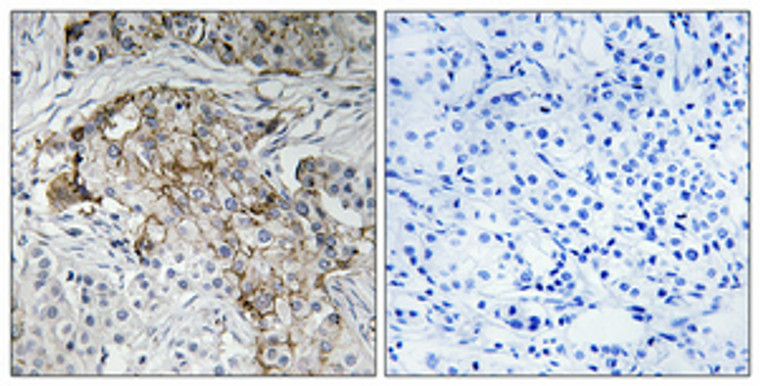| Host: |
Rabbit |
| Applications: |
WB/IHC/IF/ELISA |
| Reactivity: |
Human/Mouse/Rat |
| Note: |
STRICTLY FOR FURTHER SCIENTIFIC RESEARCH USE ONLY (RUO). MUST NOT TO BE USED IN DIAGNOSTIC OR THERAPEUTIC APPLICATIONS. |
| Short Description: |
Rabbit polyclonal antibody anti-Phospho-Amiloride-sensitive sodium channel subunit beta channel subunit beta-Thr615 (581-630 aa) is suitable for use in Western Blot, Immunohistochemistry, Immunofluorescence and ELISA research applications. |
| Clonality: |
Polyclonal |
| Conjugation: |
Unconjugated |
| Isotype: |
IgG |
| Formulation: |
Liquid in PBS containing 50% Glycerol, 0.5% BSA and 0.02% Sodium Azide. |
| Purification: |
The antibody was affinity-purified from rabbit antiserum by affinity-chromatography using epitope-specific immunogen. |
| Concentration: |
1 mg/mL |
| Dilution Range: |
WB 1:500-1:2000IHC 1:100-1:300IF 1:200-1:1000ELISA 1:10000 |
| Storage Instruction: |
Store at-20°C for up to 1 year from the date of receipt, and avoid repeat freeze-thaw cycles. |
| Gene Symbol: |
SCNN1B |
| Gene ID: |
6338 |
| Uniprot ID: |
SCNNB_HUMAN |
| Immunogen Region: |
581-630 aa |
| Specificity: |
Phospho-ENaC Beta (T615) Polyclonal Antibody detects endogenous levels of ENaC Beta protein only when phosphorylated at T615. |
| Immunogen: |
The antiserum was produced against synthesized peptide derived from the human Nonvoltage-gated Sodium Channel 1 around the phosphorylation site of Thr615 at the amino acid range 581-630 |
| Post Translational Modifications | Phosphorylated on serine and threonine residues. Aldosterone and insulin increase the basal level of phosphorylation. N-glycosylated. N-glycosylation is required for interaction with BPIFA1. |
| Function | Sodium permeable non-voltage-sensitive ion channel inhibited by the diuretic amiloride. Mediates the electrodiffusion of the luminal sodium (and water, which follows osmotically) through the apical membrane of epithelial cells. Plays an essential role in electrolyte and blood pressure homeostasis, but also in airway surface liquid homeostasis, which is important for proper clearance of mucus. Controls the reabsorption of sodium in kidney, colon, lung and sweat glands. Also plays a role in taste perception. |
| Protein Name | Amiloride-Sensitive Sodium Channel Subunit BetaBeta-NachEpithelial Na(+ Channel Subunit BetaBeta-EnacEnacbNonvoltage-Gated Sodium Channel 1 Subunit BetaScneb |
| Database Links | Reactome: R-HSA-2672351Reactome: R-HSA-9730628 |
| Cellular Localisation | Apical Cell MembraneMulti-Pass Membrane ProteinCytoplasmic Vesicle MembraneApical Membrane Of Epithelial Cells |
| Alternative Antibody Names | Anti-Amiloride-Sensitive Sodium Channel Subunit Beta antibodyAnti-Beta-Nach antibodyAnti-Epithelial Na(+ Channel Subunit Beta antibodyAnti-Beta-Enac antibodyAnti-Enacb antibodyAnti-Nonvoltage-Gated Sodium Channel 1 Subunit Beta antibodyAnti-Scneb antibodyAnti-SCNN1B antibody |
Information sourced from Uniprot.org
12 months for antibodies. 6 months for ELISA Kits. Please see website T&Cs for further guidance










